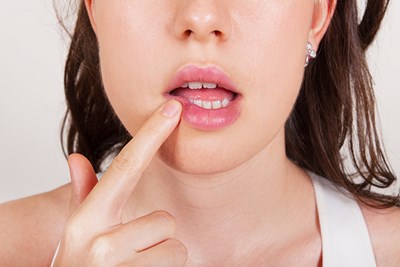Chapped lips are a form of cheilitis -- specifically irritant contact cheilitis, which is a type of dermatitis. There are several different forms of cheilitis, although this more common type is usually caused by dry, cold, or very sunny conditions. Here’s a look at the symptoms of chapped lips, as well as symptoms that might suggest your chapped lips are a different form of cheilitis.
Irritant contact cheilitis occurs when your lips become irritated from air that is too dry, windy conditions, or as a result of a sunburn. Chapped lips can be a sign of dehydration, particularly in the elderly or very young. Furthermore, chapped lips may be an allergic reaction to chemicals in lipsticks, certain metals, food products, and a variety of other allergens, generally resulting in similar symptoms.
Inflammation
“Cheil-” is a prefix used in medical terminology; “-Itis” is a suffix used to suggest inflammation. Thus, the term “cheilitis,” makes it obvious that one of the key symptoms of chapped lips, or cheilitis, is an inflammation of the lips. Whatever the cause of the irritation, it tends to result in the lips swelling up, usually just a little bit.
Cracking and Peeling
As the skin of the lips becomes irritated and swollen, other signs of chapped lips begin to follow. The irritation may cause a slight discoloration, giving your lips a much redder, rosier tint than normal. Your lips may feel uncomfortable, developing a sort of itchy pain brought on by excessive dryness. As they dry out, the skin may begin to crack. You may notice a small amount of blood between the cracks. As the cracks heal but the skin fails to come together, your lips may begin to peel or flake off.
Complications
While chapped lips generally heal themselves given time, they can get worse before that happens. If cheilitis is extreme enough, you may develop sores. The corners of the lips can crack, and the skin around the lips may also become red and swollen.
Symptoms of Other Forms of Cheilitis
Angular cheilitis is characterized specifically by issues with the corners of the lips. Rather than a normal case of chapped lips, the corners develop fissures, and may even become blistered, begin oozing, or develop a crust. Granulomatous cheilitis is a swelling that seems lumpy and often develops as a result of underlying conditions. Actinic cheilitis is a reaction to sun exposure that presents as patches of dry skin. The lower lip may periodically become thicker than normal.
Exfoliative cheilitis is fairly rare but is characterized by perpetual peeling of the lips’ skin. Pigmented contact cheilitis is generally a response to an allergy. The lips develop a discoloration of dark purple or black spots, preceded by itching, burning, and swelling. If you have experienced any of these symptoms in addition to the normal symptoms of chapped lips, it might be wise to talk to a doctor, especially as many of these conditions can be the result of an infection, allergy, or chronic disease.



